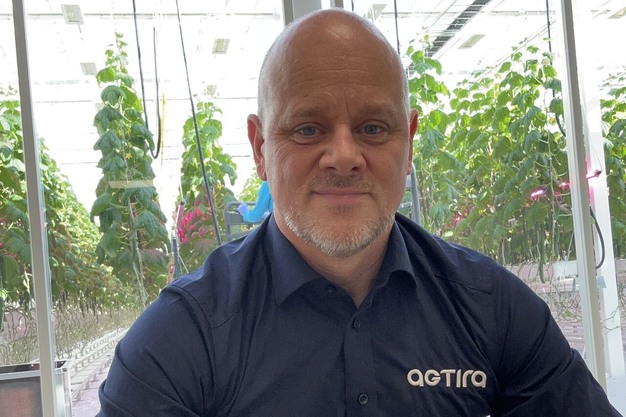Described by project partner Bas de Bekker, Sales Manager at Meteor Systems, as producing "the most sustainable indoor cucumber ever," a newly completed indoor farm in Kramfors, Sweden, is setting a new benchmark for controlled environment agriculture.
In just three months, a 2,200 m² industrial hall was converted into a high-tech cucumber farm that combines record-breaking efficiency, scalability, and commercial viability. The project, led by Patrik Löfmark from Agtira, brought together suppliers including Meteor Systems, Priva, Schetelig Oy, and Wagenaar Refrigeration B.V., achieving full-scale operations faster than traditional greenhouse builds.
From industrial shell to indoor farm in three months
The transformation relied heavily on meticulous pre-planning and precision execution. According to Löfmark, "The key to transforming an old industrial hall into a high-tech cucumber farm within just three months was meticulous planning in advance. Using advanced 3D scanning equipment with millimetre-level precision, the entire facility was digitally mapped, allowing all details, such as walls, ceilings, growing gutters, and lighting mounts, to be designed in 3D. This enabled accurate, customised orders and eliminated on-site guesswork."
Strong coordination between suppliers and installers was another critical success factor. "Thanks to precise technical preparation and well-synchronised execution, the entire transformation was completed in fast time," Löfmark added.
Energy efficiency through integrated smart systems
Several advanced technologies underpin the farm's performance:
- No active chillers or refrigerants
- 98% less water usage through precision irrigation
- CO₂ retention through advanced air recirculation
- 95% reduction in heating needs compared to traditional greenhouses
- 3.9 kWh of energy used per kilogram of cucumber produced
"A ventilation system recirculates up to 100% of the air when outdoor temperatures are below +5°C, which is the case most of the year in Northern Europe," Löfmark explained. "It recovers up to 95% of the heat, captures condensation water for irrigation, and reduces CO₂ input needs because no air is vented out."
Instead of energy-intensive cooling systems, free cooling is used from nearby lakes, rivers, or the bedrock. "Only circulation pumps and control valves consume energy—no chillers or compressors are needed," Löfmark added.
Bas de Bekker, Sales Manager at Meteor Systems, further emphasised the system's simplicity: "The technology is groundbreaking because it eliminates the need for energy-intensive chillers. It uses free cooling from the ground, which is cost-effective, always available, and highly reliable, with fewer components that can fail compared to traditional cooling systems." © Agtira
© Agtira
A system designed for Nordic conditions
Given the wide temperature swings in Sweden—from -35°C in winter to +30°C in summer—the growing space was built as a "house within a house," entirely sealed from external conditions.
"This allows for 100% control over the climate and prevents pests and insects from entering," said Löfmark. "The ventilation system is custom-designed for Nordic conditions, with a focus on heat recovery, dehumidification, and frost protection, ensuring smooth operation even in extreme cold."
Unlike traditional greenhouses, the facility has no windows, roof vents, or curtains—minimising heat loss and energy waste. © Agtira
© Agtira
Early results: Higher than expected yields
By the end of January, the facility was operational, and the first harvest followed shortly thereafter. Early results exceeded expectations.
"The cucumbers are straight, crisp, fast-growing, and of excellent quality," said Löfmark. "Both yield and energy efficiency have been strong, though exact harvest data has not yet been made public."
The first harvest also confirmed that the facility's environmental control systems were functioning as intended, supporting stable, high-yield production in a fully enclosed system.
A strategic blueprint for future food production
The Kramfors project is more than a technical achievement—it represents a strategic shift in how scalable food production can be deployed in colder climates. "The project has been a major agritechnical success," said Erik Jonuks, CEO of Agtira. "In Q1, the facility outperformed our projected estimates, with productivity matching or exceeding that of traditional high-wire greenhouse production."
Jonuks highlighted the strategic significance: "This establishment provides a new blueprint for scalable food production in central and northern Sweden, where there are many repurposed industrial buildings with ample access to power. The CAPEX is significantly lower than for a conventional greenhouse, and we benefit from precise climate control systems." © Agtira Agtira CEO, Erik Jonuks
© Agtira Agtira CEO, Erik Jonuks
He also noted the energy savings: "What stands out most is the significantly reduced energy usage, particularly for heating. While we lose solar input, we compensate with a more stable climate and vastly lower heat consumption. Success hinges on smart control systems—especially dehumidification and, to some extent, cooling."
The team at Agtira and Meteor Systems sees this facility not as an endpoint, but as a scalable model. "The system can be easily adapted to other crops, not just cucumbers," said de Bekker, indicating broader possibilities for future installations.
For more information:
Agtira![]() © Agtira Patrik Löfmark, Project Manager
© Agtira Patrik Löfmark, Project Manager
www.agtira.com
 © Meteor SystemsMeteor Systems
© Meteor SystemsMeteor Systems
Bas de Bekker, Sales Manager
www.meteorsystems.nl
